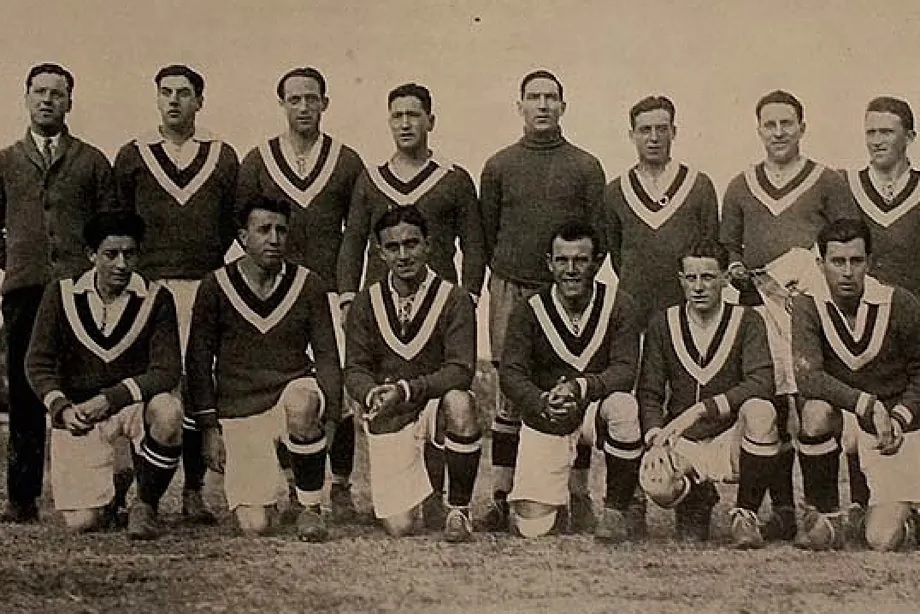This Saturday, Xabi Alonso's Madrid will play 30 kilometers from the old Hawthorn Field. They will do so at the MetLife Stadium, to the west, on the other side of the Big Apple, 20 minutes from Manhattan but already crossing the border into New Jersey. They will stay at the luxurious Four Seasons Downtown, next to the World Trade Center, and will play in the Club World Cup quarter-finals, the latest venture of modern football, against Borussia Dortmund. They aim to conquer the world.
But a century ago, everything was different for the Madrid expedition. In 1927, the Spanish League had yet to start for two more years, Madrid had turned professional just a year earlier, and was barely known outside the country. It didn't matter. Santiago Bernabéu, who ended his playing career that season, along with then-president Luis Urquijo, embarked on a trip to America that became Madrid's first transatlantic tour in history. The quest to conquer the world.
They departed from the port of Barcelona on the ship Giulio Cesare in mid-June 1927, and on July 7, they played in Buenos Aires against a city selection. It was the first of 15 matches in six countries, passing through Argentina, Uruguay, Peru, Cuba, Mexico, and the United States, where they only played one match, in September, three months after leaving Spain, against Galicia SC.
Madrid's New York debut was owed to the Jewish entrepreneur Nathan Agar, who had emigrated from England, a prominent figure in those golden years of soccer in New York and owner of the Brooklyn Wanderers, a club where Bela Guttmann played and which was initially supposed to be Madrid's opponent, a choice that was eventually discarded. The football level in the city and the East Coast was very high due to immigration, with several important leagues divided into American and International divisions, and clubs spread beyond the state of New York, reaching as far as Chicago and St. Louis. The Wanderers had already faced powerful clubs from Austria or Uruguay, and Agar, also the owner of Hawthorn Field and responsible for Madrid's visit, assigned the match against Madrid to Galicia SC.
The club, founded by Galicians a few years earlier, had become popular among the Hispanic community in New York, especially in the area now known as 'Little Spain'. They celebrated the match by inviting the Madrid expedition to a dinner at the old and luxurious Hotel Pennsylvania, built in 1919, the world's largest at the time, located next to Madison Square Garden and demolished in 2023.
There, players from Madrid dined, including signings of several players from other Spanish clubs just for the tour and with some absences due to family reasons because of the travel difficulty, alongside Galician players, some of whom were of other nationalities. The next day, Real Madrid and Galicia SC drew 1-1 at Hawthorn Field. According to a report in the New York Times the following day, 5,000 fans attended, a number far from the 46,000 at the match between Brooklyn Wanderers and Hakoah Vienna from Czechoslovakia the previous year (a record in the US until Pelé arrived). The newspaper headlined "A Spanish team draws with Galicia in Brooklyn."
"Galicia was better in the first half, but the Spaniards found their rhythm later and put on a football display. Félix Pérez, a slender winger, received applause from the crowd several times for his quality," wrote the New York Times. In the stands was the Spanish consul in the city, also Galician, Rafael Casares y Gil, who helped promote the Galician Center in New York.
"We played almost like family because there was little promotion for the match. Galicia had everything except Galicians: Czechs, Irish, Italians... These are the kings of distributing kicks," Bernabéu reportedly said upon returning to Spain, according to newspapers of the time. The lineup shows that Galicia had José, Guerra, Vega, Rodríguez, and Costa... And also Kuhr, Wall, Findlay, Ferguson, and Schneider. They would end up touring and reaching Havana. In Madrid, José María Peña, an Olympian with Spain in 1924 and the first player to sign a professional contract in the club's history; Lope Peña and Del Campo, who won three regional championships with the club and were part of the team that debuted in the League years later, or Desiderio Esparza, who stayed until 1933 and won two Leagues. A century later, Madrid returns to New York to conquer the Club World Cup.
